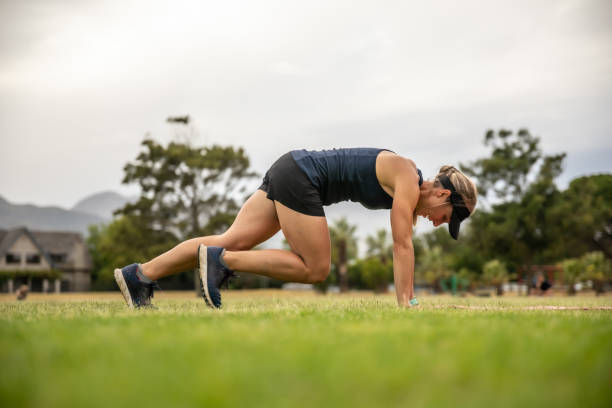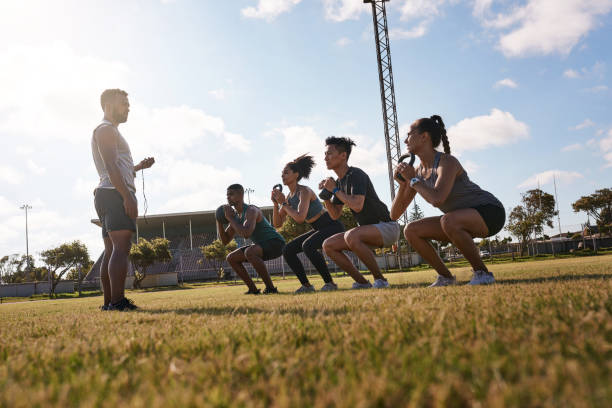Understanding the Benefits of Cross-Training for Runners
Discover more about the advantages of adding cross-training to your running routine and how it can help you reach your fitness goals!
The Advantages of Cross-Training
Cross-training is an essential part of any runner’s training regime. Not only does it offer the same cardiovascular benefits as running, but it also works on strengthening and stretching other muscles that are not used when running.
It helps to improve overall strength, balance, and core function so runners can perform better during their runs while reducing chances for injury from repetitive motion. Cross-training also gives runners a much-needed break from running since it takes some of the strain off regularly used muscles while giving them the opportunity to use different muscle groups.
Working out with different cross-training exercises provides variety in the workout routine, which will help keep training interesting by challenging our bodies differently each time we exercise, ultimately resulting in improved performance quickly.
How Cross-Training Prevents Injuries
Cross-training is essential for runners looking to prevent injuries. When done correctly, it can bolster strength and conditioning across the board, providing a substantial buffer against running-related issues caused by imbalances in condition or overuse of certain muscles.
Cross-training helps build overall cardio endurance while simultaneously eliminating weak spots that could lead to injury later on down the line. It also improves muscle strength in neglected areas, which works towards preventing potential sports injuries from arising.
Not only that, cross-training can help balance muscular strength and flexibility across different muscle groups for better stability and mobility—both of which are key components when it comes to avoiding injury, too! Ultimately, engaging with regular cross-training as part of your workout routine strengthens all other aspects of physical fitness behind just running—which makes you more resilient overall!
Preventing Burnout and Over-Training with Cross-Training

Cross-training for runners is an effective way to stay in top shape and stay motivated. Incorporating different types of exercise will deliver numerous advantages for runners, allowing them to add more physical activity without the risk of repetitive strain injuries.
Such activities can also improve a runner’s overall fitness, enhancing strength and flexibility throughout the entire body while reducing the likelihood of running-related injuries as well as exhaustion due to overuse or burnout.
In other words, cross-training workouts add diversity to your training schedule, which keeps you engaged with your routine, preventing boredom that may then lead to slacking in motivation or focus levels.
Incorporating exercises like pool running, cycling/spinning classes, and yoga alongside running can benefit greater muscle recruitment, leading to better-sustained performance whilst helping build strength, balance, and endurance – all key components required by any runner when attempting various terrain trails.
Using Cross-Training to Add Volume to Your Training
Cross-training is an ideal way for runners to add more volume to their training by diversifying their workouts and adding new exercises to the mix. Not only does cross-training help improve overall strength and balance, but it can also benefit running performances due to increased muscular endurance.
Popular cross-training activities among runners include biking, swimming, strength training exercises, low-impact workouts, balance drills, and other flexibility exercises. Biking targets areas like your glutes, calves, quads, and hips, while swimming builds up a runner’s endurance, speed, agility, and joint health.
Cross-training helps prevent burnout from repetitive running motions since many of these activities involve different muscle groups not accustomed to regular use. Ultimately, performers should use this extra time in their schedule to focus on improving weak spots or setting goals they would otherwise not be able to achieve by just running alone.
Diversifying Your Running Schedule with Cross-Training

Incorporating cross-training into your running program helps to increase diversity in your exercise routine and guard against overuse injuries.
Introduction to a Runner’s Cross-Training Program
Cross-training is an essential part of a runner’s training routine. Adding different exercises and activities into your regular running schedule helps build strength, increases stamina, boosts mental focus, and optimizes performance.
Incorporating a cross-training program can not only help runners improve in their chosen sport, but it also helps to prevent injuries due to its strengthening effects on the body. Cross-training helps runners build up key muscles in their legs that are usually bogged down by traditional training methods such as running or jogging alone.
Better yet, introducing different forms of cross-training into a workout regimen gives athletes with varying levels of experience new challenges to develop themselves better athletically while decreasing injury risk along the way.
How to Incorporate Cross-Training into Your Training Plan
We all know how important running is for our cardiovascular health. But cross-training is essential, too! Incorporating cross train as an additional activity into your routine will prevent injuries, provide a balanced training schedule, and ultimately lead to improved performance. Here are some tips on how to effectively incorporate cross-training into your running program:
- Understand the benefits of diversifying your fitness routine with cross-training activities such as biking, yoga, strength training, climbing, and soccer. These minimalist exercises strengthen other muscle groups that may be neglected or overused during running—ensuring you stay injury-free year round!
- Start by adding one cross-trained workout each week until eventually reaching 2–3 days of alternative exercise per week in order to achieve a balanced approach of varied physical activities that don’t overly strain the body from overexertion but support an individual runner’s tailored goals
- Choose the right apparel and footwear for different forms of training – cross-country shoes usually make great alternate pairs when rock climbing or bowling; cleated athletic shoes can also be used for soccer practice drills; and switches between sneakers while jumping rope help save wear off (especially useful when budgeting). Using this technique not only prevents repetitive strain on certain tired muscles but also helps maximize any financial investments made towards multiples of sportswear throughout a yearly span.
Utilizing Off-Season for New Cross-Training Activities

During the off-season, runners can benefit from introducing a variety of cross-training activities to their workout routine. Cross-training helps with aerobic fitness and can target weak areas that running alone may not address.
Incorporating activities like cycling and using elliptical trainers are great cardiovascular workouts that help improve endurance levels and boost overall performance. At home or in the gym, strength training is an important component of cross-training for runners – adding exercises like squats, planks, and lunges will build muscle and prevent injuries caused by overuse during races or intense training periods.
Types of Cross-Training Suitable for Runners
Exploring different exercises, strength training, and HIIT workouts to incorporate into your run training plan. Make sure you have the right tools in place so that you get maximum benefits from your cross-training program!
Exploring Different Cross-Training Exercises for Runners
Cross-training is an important element of a running program, and diversifying your training with alternative exercises can provide powerful benefits. From biking to yoga, strength training to climbing, there are many different types of cross-training you can incorporate into your routine.
These activities don’t only help you become a better runner—they also help reduce the risk of injury by providing similar cardiovascular benefits while reducing bone stress and fatigue at the same time.
Strength training is especially beneficial for runners as it helps strengthen other muscles that aren’t used in running, helping keep muscles diverse and maintain balance in movement & recovery.
Strength Training as a Form of Cross-Training
Strength training offers a wealth of benefits for runners looking to up their game. Strength training is considered an essential form of Cross-Training as it provides the opportunity for new adaptations beyond what cardiovascular exercise can provide.
It helps strengthen other muscle groups, reduce imbalances, and prevent injuries from overuse.
By using specific exercises such as squats, deadlifts, lunges, pushups, or planks, you can achieve total body strength and flexibility. Not only do these exercises improve your overall performance, but they also increase your endurance and stability while helping to prevent injury by strengthening smaller, stabilizing muscles around the joints that support movement.
Choosing the Right Cross-Training Workout Routine for Your Purpose
Finding the right cross-training workout is key to staying injury-free and getting the most out of your running program. There are a variety of exercises suitable for runners, each with different benefits.
Strength training can help increase speed and power while reducing fatigue during hard runs. Yoga promotes better balance, stability, and joint flexibility that translates into a smoother stride on long-distance runs.
Swimming builds cardiovascular endurance without putting stress on joints like other forms of exercise do; its low-impact nature also makes it an ideal choice for busy or injured runners who need some downtime between sessions.
Plyometrics improve the explosiveness of running by developing fast twitch muscles; these explosive exercises should be saved as more intense workouts in order to keep energy levels up over time.
Cycling complements any runner’s training since biking requires endurance but has fewer repetitive foot strikes than running; this helps maintain running performance while preventing overuse injuries from setting in too quickly due to a lack of recovery days throughout the week.
Implementing Cross-Training Workouts in Your Running Program

Start small and progress slowly when adding cross-training workouts into your running program by beginning with low-intensity activities such as walking, cycling, or swimming.
Starting Running Cross-Training Workouts
As runners, it is essential to add cross-training into our training routine in order to sustain a healthy and injury-free running journey. Incorporating cross-training exercises helps us target different muscle groups, which can prevent overuse injuries common for runners.
Some activities such as cycling, swimming, or yoga are suitable cross-training activities that engage the main muscles used in running, like the glutes, calves, quads, and hips, while enhancing overall cardiovascular fitness, and strength.
We should start with low-intensity exercises at a comfortable pace before gradually increasing the duration and faster tempo of these workouts as we progress along our running journey.
Cross-Training Shoes: What You Need to Know
It is knowing which footwear to wear when cross-training is important for optimal performance and preventing injuries.
Are Running Shoes Suitable for Cross-Training?
When it comes to the best cross training exercises in-training, the shoe you choose is just as important as any other piece of equipment. Running shoes are not designed with cross-training activities in mind and may lack the additional support and stability that is needed when performing dynamic workouts like HIIT, circuit training, or weight lifting.
Cross-training shoes are much more versatile because they are designed with cushioning, reinforced support, and increased grip in order to hold up during multiple types of exercise routines.
Cross-training shoes can provide extra breathability, which helps keep your feet cool during high-intensity exercises. Additionally, these shoes tend to be heavier than running shoes because they offer stronger construction for supports such as lateral movement, side traction, and higher impact activities like jumping rope or plyometric drills.
While running shoes may work for low-impact cardio movements like light jogging on a treadmill or elliptical machine, their lightweight soles may not be supportive enough for complex multi—directional movements common in most workout classes.
Selecting the Right Footwear for Cross-Training
As runners, it’s essential to choose the right pair of shoes for your cross training session and routine. While there are conventional running shoes available, they may only be suitable for some activities in your cross-training program. Cross-training involves various movements, such as lifting weights and participating in aerobic exercise, so a multipurpose shoe is important to support different physical demands from our body. Here are some key factors to consider when selecting the right footwear for cross-training:
- Flexibility: Cross training requires dynamic movements such as jumping and lateral movement drills, making flexibility an important attribute in cross trainers. Look for a shoe with flexible cushioning that can handle multiple planes of motion during workouts.
- Comfort: The comfort factor depends on how long you’ll wear them throughout your session; if longer sessions are what you typically do, then look into higher-quality cushioning designs within the midsole and upper part of the shoe, which provide proper foot alignment while working out, allowing optimal range make sure the upper, breathable component helps keep feet dry even after hours at a time wearing them!
- Supportive Structure & Durability: Good arch support will ensure proper balance while performing multiple squats or explosive exercises such as plyometrics; too often, stability features found within certain styles help reduce risk tendon strains maintaining full control during runs reducing impact forces acting upon lower extremities due to shock absorbing midsoles plus outsoles providing traction surfaces, helping preventing every slipping falls – forgetting don’t forget extra layer resilient rubber compound soles more resistance abrasion tear offering durability many years come!
Cross-Training Activities to Approach with Caution

It’s important to be aware of the potentially risky activities associated with cross-training and understand appropriate precautions in order to ensure a safe and effective workout.
Identifying Potentially Risky Cross-Training Activities
For runners looking to achieve their fitness goals and improve their running performance through cross training good, it is important to understand the types of cross-training activities that may put them at a higher risk for injury. To maximize benefits from your training program while minimizing potential risks, here are a few potentially risky cross-training activities to approach with caution:
- High-Impact Exercises – Activities such as plyometrics and HIIT can involve significant impacts on joints, so it’s best to keep high-impact exercises within recommended dosages or avoid them altogether if you’re already dealing with an existing injury.
- Unstable Surface Workouts – Movements executed on unstable surfaces (such as BOSU balance trainers) can also prove dangerous for runners due to the increased stress placed on muscles and joints in order to stabilize the body during movement. Runners should only attempt these challenging workouts if they have adequate strength, proper form, and experience with selected exercise movements beforehand.
- Longer Running Activities – With limited rest between runs during longer runs, there can always be excessive loading tension applied to the skeleton, causing overuse issues like inflammation, Achilles tendon bursitis, etc. This research shows adaption takes many one-time short run loads better than the same sum combined into fewer long walks, so adding the appropriate amount of volume breaks focused on number chunks rather than just one single whether resistant efforts split training plan performance weekly slightly lower than low-risk gains more sometimes wiser move than hitting race distances all repeatedly week after week leading injuries cortisone series shots less optimal finish line times & therefore usually not desired result doable prevention alternative strategy most maybe never tap!
Understanding When to Avoid Certain Cross-Training Exercises
As runners, cross-training is an essential part of our journey to better health and performance. However, only some cross-training activities are suitable for us. We must consider what exercises are best for us given our training goals and footwear, as well as the potential risks involved with any particular cross training prevent injuries or exercise.
It’s important to listen to your body when selecting activities that are right for you. In general, we should avoid high-impact movements or activities that involve too much stress on heavily stressed joints, such as running on concrete surfaces or excessive plyometrics.
Frequency and Scheduling of Cross-Training for Runners

To ensure you get the most out of your cross-training experience, calculating an optimal frequency and writing a scheduling plan is key to success.
Determining the Optimal Number of Cross-Training Days per Week
Cross-training is an important part of any runner’s routine, as it helps prevent burnout and injuries associated with running. But what’s the optimal amount of cross-training for runners? How many days per week should you incorporate cross-training into your schedule, and how can you determine the best number of days to maintain a balanced training program?
The ideal number of cross-training sessions per week may vary depending on factors such as an individual’s training volume, goals, fitness level, recovery needs, etc. It’s generally recommended to include two or three days of light cross-training in addition to your regular running schedule each week.
This includes strength exercises like core work or low-impact activities like swimming and cycling, which not only increase endurance but also help build muscular balance and stability necessary for strong running performance.
If you need more intense cross-training workouts during high mileage weeks when rest is tougher to achieve due to time restrictions, then listen to your body and adjust accordingly.
How to Include Cross-Training in Your Running Schedule.
As runners, it’s important to make sure that we balance our routines by incorporating cross-training activities into our schedule. Regular days off for recovery between running sessions is essential, but mixing up your routine with supplementary exercises can also help reduce the risk of injury and improve overall fitness levels.
So, how about adding cross-training to your running routine? It’s also wise to review and adjust what exercise makes sense each season, depending on workload. Cross-training helps ensure adequate muscle diversity, which will give extra stability when doing high-impact activities regularly like running, which has the potential to cause overuse injuries if done too often.


Leave a Reply